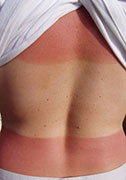- Planters Peanut Products Under Recall Due to Listeria Risk
- That ‘New Car Smell’ Could Be Toxic Carcinogens
- Gene Discovery Points to a New Form of Alzheimer’s
- Scientists May Have Located Your Brain’s ‘Neural Compass’
- Almost All Counterfeit Oxycontin Pills Contain Fentanyl
- A Parent’s Watchful Eye Does Keep Kids From Drugs, Alcohol: Study
- AI Might Boost Detection of A-Fib
- Drug May Help Folks Kick the Vaping Habit
- Small Pump May Let Kids Stay Home As They Await New Heart
- Gene Therapy Improves Vision in People With Inherited Blindness
5 or More Bad Sunburns While Young Tied to Higher Melanoma Risk


White women who get five or more blistering sunburns between the ages of 15 and 20 have an 80 percent increased risk for melanoma — the most deadly form of skin cancer, new study findings indicate.
Researchers also found these women have a 68 percent greater risk for two other forms of skin cancer known as basal cell carcinoma and squamous cell carcinoma.
“Our results suggest that sun exposures in both early life and adulthood were predictive of non-melanoma skin cancers, whereas melanoma risk was predominantly associated with sun exposure in early life,” according to Dr. Abrar Qureshi, professor and chair of the department of dermatology at Brown University and Rhode Island Hospital in Providence.
“Parents may need to be advised to pay more attention to protection from early-life sun exposure for their kids in order to reduce the likelihood of developing melanoma as they grow up. Older individuals should also be cautious with their sun exposure, because cumulative sun exposure increases skin cancer risk as well,” Qureshi said in a news release from the American Association for Cancer Research.
In conducting the study, published May 29 in the journal Cancer Epidemiology, Biomarkers & Prevention, the researchers followed nearly 109,000 white female nurses for about 20 years. When the study began, the women were aged 25 to 42. They were asked about their medical history. The researchers also assessed their risk factors for skin cancer, such as the number of moles they had, if they had a family history of the disease and the number of blistering sunburns they had in their late teens.
Over the course of the study, the investigators collected more recent information from the women on their skin cancer risk. Specifically, they were asked for updates on their family history as well as their use of tanning beds, alcohol and cigarettes.
The study participants lived in 14 different states. The researchers took this into account and calculated each woman’s total ultraviolet (UV) light exposure, depending on how long they lived in any given place. The women were placed into three categories based on this UV exposure: low, medium and high.
Roughly one-quarter of the women experienced painful blistering sunburns at a young age and one-quarter admitted to using tanning beds. The researchers also found that about 10 percent of the women had more than five blistering sunburns when they were between the ages of 15 and 20.
Nearly 7,000 were diagnosed with basal cell carcinoma. Squamous cell carcinoma affected 880 of the women and about 780 were diagnosed with melanoma. Of the women who developed melanoma, 445 had invasive cancer, the investigators found.
The study authors pointed out that the women who had the greatest exposure to the sun’s harmful UV rays when they were adults did not have an increased risk for melanoma. These women, however, had a roughly 2.3-fold greater risk for basal cell carcinoma and a 2.5-fold increased risk for squamous cell carcinoma.
“Pattern of sun exposure was not uniformly associated with the risk for all the three main skin cancers we see in the United States, suggesting that there are some differences in the [development] of these skin cancers,” noted Qureshi.
“An individual’s risk of developing skin cancer depends on both host and environmental risk factors. Persons with high host-risk traits, such as red hair color, higher number of moles and high sunburn susceptibility, should pay more attention to avoid excessive sun exposure, especially early in life.”
More information
The U.S. National Library of Medicine has more about melanoma.
Source: HealthDay
Copyright © 2024 HealthDay. All rights reserved.










